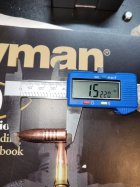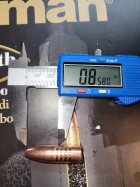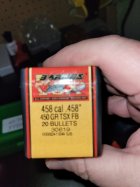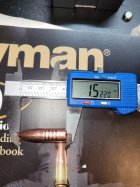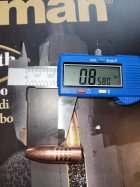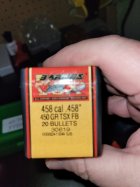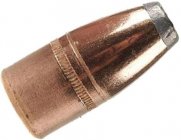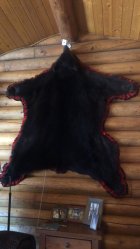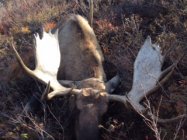Hi, thks for your input,I have 3 loading manuals,Lyman,Hornady and Lee, been reloading 243,308 and 7 rem mag, it's just that I bought these bullets by mistake(458) and couldn't find any info online if I could use them in my new Winchester 1886 45-70.....Bottom line: Give up on the idea and try to sell those bullets. Then try to find some cast lead .458" flat-points at about 350 to 405 grains and a good powder in the range of maybe H322 or IMR 3031. The listed suggestions should make it easier to craft loads that will feed and cycle in your firearm. Using the loading manual that you should not take another step before buying, work carefully from a starting load up.
Only do this after you have read and re-read the loading section and data.
Best of all, locate an experienced loader in your area who can mentor you. Much easier than asking partial questions lacking important details and people trying to figure out how to help you. Everyone is willing to help, but you have to do your part too.
You are using an out of date browser. It may not display this or other websites correctly.
You should upgrade or use an alternative browser.
You should upgrade or use an alternative browser.
45cal in 45-70 brass
- Thread starter newshooter
- Start date
Bottom line: Give up on the idea and try to sell those bullets. Then try to find some cast lead .458" flat-points at about 350 to 405 grains and a good powder in the range of maybe H322 or IMR 3031. The listed suggestions should make it easier to craft loads that will feed and cycle in your firearm. Using the loading manual that you should not take another step before buying, work carefully from a starting load up.
Only do this after you have read and re-read the loading section and data.
Best of all, locate an experienced loader in your area who can mentor you. Much easier than asking partial questions lacking important details and people trying to figure out how to help you. Everyone is willing to help, but you have to do your part too.
Attachments
2.630 is the longest I can get to cycle through my 1886 action before I have issues. I would seat the bullets at their correct length for the cannelure and chamber them singley.
No sense in pushing velocities really high, H4895, IMR4895, IMR4198, AA5744, etc all work great in even in reduced charge weights.
No sense in pushing velocities really high, H4895, IMR4895, IMR4198, AA5744, etc all work great in even in reduced charge weights.
dellet
Gold $$ Contributor
What I have in post #24 was poorly written. It was not meant to question the action strength as much as the load data by Barnes.The browning designed 1886 is WAY stronger than a Marlin action. Marlin's weakpoints are the recievers which become a failure point when north of 43,000psi, this isn't an issue on the Winchesters. Manufacturers like Big Horn Armory chamber 1892's(a smaller derivative of the 1886) in 460 S&W(60,000psi).
I would only use trapdoor data if it was an original 1886 and never above it, but any modern reproduction is easily stronger than any Marlin period.
Barnes data is listed as Ruger #1 and Marlin 1895 loads. They state that their loads are tested to 42,000 PSI for the Marlin vs 55,000 for the Ruger. That was the distinction I was meaning to reference.
Using Their Marlin data in different rifles, one 1886 Browning, the others were 1885, showed severely flattened primers in the 1886 and one of the 1885's at just over starting loads. They also use a couple not so popular powders, 1680 and N120.
Same powder charges and relative seating depth using jacketed bullets, did not have the same flattened primers. I don't shoot Barnes bullets in my 45-70's but when I tried them, my experience was early pressures signs at lower charge weights that seemed more bullet design/composition related than weight.
I shoot a 550 grain cast in the Browning 1886 that is about 1.450" long. Feeds and chambers fine at 2.765" and is stable out to 400 yards at 1300 MV. Farthest I have shot it.
I think stability may be the biggest problem with the 450 grain Barnes in a 1/20 twist. it might be fine at short distances. Expansion is not really on the table.
I do remember looking at some of Barnes data and thinking that sounds hot.Using Their Marlin data in different rifles, one 1886 Browning, the others were 1885, showed severely flattened primers in the 1886 and one of the 1885's at just over starting loads.
I seldom load much above trapdoor levels anyway because I like my shoulder and if I'm hunting with cast it will go through the animal at any speed.
snert
Silver $$ Contributor
I in the "nope, sell them" crowd. I think you are wasting good bullets in a kinda worthless pursuit, cause you are not going to get the velocity you need to make them "work". They will be like a solid.
You can find some cast lead bullets if you look, and they will shoot MUCH better in your application than these mistake bullets.
You can find some cast lead bullets if you look, and they will shoot MUCH better in your application than these mistake bullets.

45-70 300 Grain RNFP Hi-Tek Coated Bullets – ACME Bullet Company - ACME Bullet Company
Round Nose Flat Point (RNFP). Sized to .458 OAL .770 +/- These bullets are cast from 92-6-2 alloy (BHN 16) and are then coated in Hi-Tek coating.
I prefer the Speer 350gr FN that is designed for the 458 Mag in my Marlin 45-70. A excellent bullet at 1900 to 2000 fps expansion and retention is excellent very similar to bonded bullet performance in my 45-70.
For bullet design if you have a tubular rifle like the Marlin I do not suggest pointed bullets. The Speer 350 gr works great in Tubular magazines but some like the pointed Barnes bullets would work in Ruger No 1 single fired weapons and like.
For bullet design if you have a tubular rifle like the Marlin I do not suggest pointed bullets. The Speer 350 gr works great in Tubular magazines but some like the pointed Barnes bullets would work in Ruger No 1 single fired weapons and like.
Attachments
Last edited:
Ran the #'s and at 2.620" COAL, the MAX charge weight would be around 34 gr of H-4895. I'd start at 31 gr.2.630 is the longest I can get to cycle through my 1886 action before I have issues. I would seat the bullets at their correct length for the cannelure and chamber them singley.
No sense in pushing velocities really high, H4895, IMR4895, IMR4198, AA5744, etc all work great in even in reduced charge weights.
When loaded at 2.620", I hope the case mouth is still on the bearing surface of the bullet and not the nose.
Software predicts 31 gr H-4895 = 21,000 psi and 34 gr = 26,000 psi.
I think for that bullet, it would be on the nose. If you must shoot them then better to just treat it like a single shot, seat them to the last groove and have some really long bullets.When loaded at 2.620", I hope the case mouth is still on the bearing surface of the bullet and not the nose.
rockhound78
Silver $$ Contributor
I would suggest some 350-400gr Powder coated RNFP 0.458 or 0.459" diameter bullets. Many cast bullet suppliers have such a critter in their catalogs online. Looks like your bullets are for the 458 mag and .458" diameter. As said, try and sell those and get the appropriate bullets for your '86
Similar threads
Upgrades & Donations
This Forum's expenses are primarily paid by member contributions. You can upgrade your Forum membership in seconds. Gold and Silver members get unlimited FREE classifieds for one year. Gold members can upload custom avatars.

Click Upgrade Membership Button ABOVE to get Gold or Silver Status.
You can also donate any amount, large or small, with the button below. Include your Forum Name in the PayPal Notes field.
To DONATE by CHECK, or make a recurring donation, CLICK HERE to learn how.

Click Upgrade Membership Button ABOVE to get Gold or Silver Status.
You can also donate any amount, large or small, with the button below. Include your Forum Name in the PayPal Notes field.
To DONATE by CHECK, or make a recurring donation, CLICK HERE to learn how.










